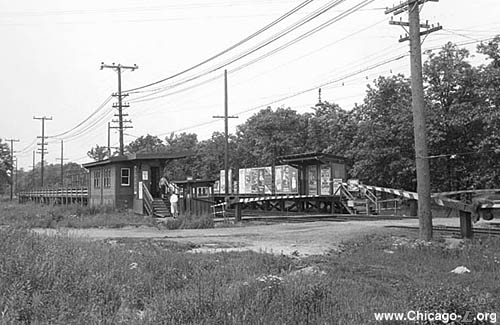
When Isabella first opened,
the border of Evanston and Wilmette was sparsely populated.
Over 15 years later, when this view was shot on June 27,
1928, Isabella Street was still an unpaved road and open
land was still abundant, but the station sported a brand new
headhouse. Within a few years, however, single-family homes
on generous lots would fill out the neighborhood. For a
larger view, click here.
(Photo courtesy of M.D. McCarter,
Collection of JJ Sedelmaier Productions)
|
Isabella
(2800N/1200W)
Isabella Street and Asbury
Avenue, City of Evanston
Service
Notes:

|
Evanston
Line
|
Quick Facts:
Address: 1215 Isabella
Street, Evanston
Established: April 1, 1912
Original Line: Northwestern Elevated Railroad, Evanston
branch
Previous Names: none
Skip-Stop Type: All-Stop
Rebuilt: n/a
Status: Demolished
History:
The "L"s original foray into Evanston via the Chicago, Milwaukee
& St. Paul's tracks in 1908 ran only to Central
Street, about a half-mile from the northern border of the North
Shore suburb. In 1912, Northwestern President Britton I. Budd
announced that he intended to extend the Northwestern through north
Evanston and into Wilmette. Opposition quickly developed in the new
village, but after some haggling and construction of a temporary
extension under the cover of night on April 1, Wilmette had "L"
service. Isabella was the only intermediate stop built between
Central and Linden
in Wilmette.
Isabella has always been a small residential stop with modest
ridership. When the station was built, the land around it was largely
open and undeveloped, with a few houses dotting the landscape. Soon,
there were rows of single family homes on generous lots. Still, the
area had not achieved a particularly high density.
The ground-level station had two side platforms. Originally, the
station had no headhouse, just the two side high-level platforms with
stairs at the south ends leading to the street. The northbound
platform always had a windbreak shelter. The shelter was a small
three-sided enclosure with a wide roof that acted a large windbreak
and protective cover, just large enough for a bench and a few
standees. Evidence suggests that the southbound platform gained one
as well sometime before the mid-1920s. There was no building and no
ticket agent on location.
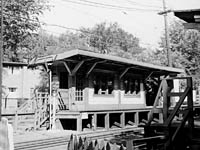
The inbound station house is
seen here on July 24, 1967 looking northwest after the
gateman's shanty has been removed. Visible here are the
Craftsman-influenced eave brackets and the sidedoor that led
directly to the platform for pay-on-train periods. For a
larger view, click here.
(CTA photo, Graham Garfield
Collection)
|
Circa 1926, a station house was added on the inbound (west)
platform. A short canopy projected from the rear of this wood-frame
station house covering part of the platform. The outbound platform
still had no headhouse and no real fare controls of any kind. It was
probably assumed that few people would ride from Isabella to Linden
at the end of the line just a few blocks away, and what few people
did decide to board here could have their fares collected by the
conductor.
The station house was a small wood-frame structure set atop of the
south end of the southbound platform near the street. The simple
clapboard building had overhanging eaves -- especially on the
trackside, where it doubled as a shallow canopy over the thin
platform extension that extended along the east side of the building
-- with exposed rafters and heavy timber brackets supporting the
slightly angled roof. The architecturally vernacular headhouse
employed some influences from the Craftsman style, mostly in the
multi-paned design of the doors and windows, as well as in the
bracketed eaves, but was mostly a functional form. The roof extended
a few feet north of the building, supported by a single centerpost
with angled brackets, to act as a short (perhaps a half-car length)
canopy. The interior was small and largely open, except for an
agent's booth and porter's closet in the southwest corner of the
interior. Originally, the station also had a iron stove for heat,
which remained in place as late as the late 1960s. The walls were
plaster with varnished wood moldings, but by the early 1970s the
entire interior had simply been whitewashed except for the doors and
floor moldings. The station house had a couple ways it could be
modified for pay-on-train periods, including a gate next to the front
door that could be opened and a sidedoor inside next to the front
entrance that could be unlocked, both of which led directly to the
thin stretch of boarding platform along the east (track-) side of the
building. These were both designed to bypass the agent's booth, but
they seem unnecessary as the station never had a turnstile and it
seems it would have been just as easy to allow people to simply walk
though the station house and out the normal back door when no agent
was on duty, as people no doubt did.
There was also a ground-level shack used by the gatekeeper located
in front of the inbound station house right on the Isabella sidewalk
between the tracks and the walkway to the headhouse. It housed the
employee who controlled the crossing gates back when the gates were
manually operated. The gatekeeper's shack was unusual in that it also
seems to have had a ticket agent's window to the left of the door,
located at mid-cabin on the sidewalk leading to the station steps. It
is unclear whether or when it was used to collect fares, although by
the 1960s there were vestigial fare-collection counters up near the
roof. The old gatekeeper at that time, Tom Quinn, believed it once
had been used for fare collection, but was uncertain in what
capacity. The gateman's shanty became unneeded when electric
automatic gates were installed in Spring 1960 and the hut was
subsequently removed.
One individual who grew up next to the station in the late 1950s
and 1960s recalls that the gateman's shanty had a flower box on the
front, a gong above the window to alert the cars the gates were going
down, and the vestigial fare equipment that was complete, including
the ropes, but had no registers attached. He also recalls that there
was a gumball machine into the late '50s on the platform just outside
of the door at the north end of the station house.
The Evanston Line has a varied history of switching between
operating off third rail and off overhead wire in various stretches
and at various times, dating back to the time when parts of the line
ran at-grade and the City of Evanston forbad use of unprotected third
rail on ground-level trackage. Even after the line through the entire
length of Evanston was elevated by the early 1930s, the line
continued to run off overhead. However, the Wilmette portion north of
Isabella began to use third rail in 1913 and trains made the
transition at Isabella. This extreme north end of the Evanston Line
apparently switched from third rail to trolley wire circa 1957, about
the same time that wood-steel equipment was removed from the line,
ending the practice of raising and lowering the trolley poles at
Isabella. The entire line went to third rail in 1973 and at the
insistence of the Village of Wilmette cyclone fence gates, which
block access to the "L" right-of-way but automatically swing out of
the way when a train approaches, were installed at the grade
crossings at Maple and Isabella to prevent the risk of trespasser
electrocution from the third rail.
Isabella, by its nature, always had low ridership, some of the
lowest on the system. Development in north Evanston helped a bit, but
by the standards of the time it still had modest boarding levels: the
station went from a mere 14,000 annual boardings in its early years
to 108,955 in 1930. As a result, Isabella southbound became a flag
stop, one of only two on the "L" system (Calvary
was the other). Inside the station, riders were given instructions on
painted signs to use a signal on the platform to alert the motormen
of approaching trains. Waiting passengers altered a train to stop by
pulling on a rope connected to a semaphore. The motorman would
acknowledge the signal by blowing the whistle. Riders on trains who
wished to alight simply told the crewman in their car. The station
was never a flag stop northbound -- trains always stopped -- perhaps
because there were always enough riders wishing to alight to justify
the stop. There certainly were few people waiting to board
northbound! Isabella also seems to have functioned as a flag stop for
North Shore Line interurban local trains as well.
By the time of the CTA® era
the concept of flag stops had disappeared, but ridership continued to
drop. Following the assumption of "L" service by the
CTA® in 1947, ridership at
Isabella continued to fall following the station's 1930 high. The
year the CTA® took over, annual
ridership had dropped to 93,133 (not counting passengers whose fares
were collected by conductors at pay on train periods). It continued
to tumble, with 57,987 boarding passengers in 1960 and 47,212 in
1970. By the early 1970s, it would not be uncommon for the station
agent to collect few enough fares in one shift to count them all on
the fingers of both hands. The
CTA® might have eliminated the
agent at Isabella altogether except that the Evanston stations had to
be staffed when the Evanston
Express was running, as the conductors didn't collect fares on
these trains. As a result, the ticket agents at slow stations like
Isabella worked split tricks and often the afternoon trick was a
"scrub", a leftover, short piece of work that didn't fit into a
regular trick of eight hours and which may, but did not necessarily,
include work at more than one location to fill out a full 8-hour
shift. However, as of July 12, 1972, the afternoon scrub trick at
Isabella worked only at that station, reporting and turning in the
day's receipts to the clerk at Linden
terminal.
By this time, the future of Isabella station
seemed preordained by CTA®. In
1970, the station became one of a few that were designated as
allowing inbound boarding only. (A similar arrangement was put in
place at the same time at King Drive,
Cottage Grove and University
on the Jackson Park
branch. It was later instituted at other locations, such as
Laramie/Lake.) Passengers could board
and alight southbound, but could only alight northbound. However,
beyond the stern word of the conductor, there were still no positive
control devices or barriers that stopped one from accessing the
northbound platform and few people ever boarded northbound
anyway.
Isabella's low ridership, combined with
CTA's® financial troubles made
it an easy and early target for closure. An attempt was made to close
the station in the early 1970s and it was scheduled to have service
withdrawn on April 30, 1971, but this was strongly opposed by
neighborhood residents who did not want to lose their small local
transit stop and the closure was stopped by a court injunction. The
station struggled on for a few more years -- ridership continued to
drop a few thousand more each year -- but finally fell victim to one
of several service cuts in 1973 that saw several stations and station
entrances close in the face of a financial crisis. Isabella closed on
July 16, 1973, the day that the Paulina entrance to Medical
Center also closed. Though the station remained intact for a
short time after closure, it was demolished beginning around April
1974. Sections of platform remained for a short period after that,
with some remnants lasting at least into 1975.
A few remnants that revealed the existence of the station lived on
for a while. For many years, the sidewalks that led from the north
side of the street to the side platforms could still be seen in the
underbrush of the "L" right-of-way. They were removed circa 2005. Two
of the bases from the old manual gates still existed until their
removal at the end of 2005.
The station served the National College of Education, now
National-Louis University's Evanston Campus.
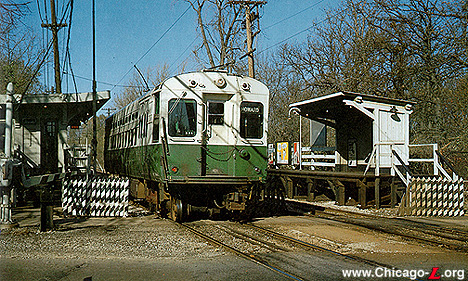
In 1967, cars
1-50
were repainted with the Alpine white and Mint green color
scheme that the first order of the 2000-series were
delivered with. One of these repaints, seen here on the
Howard-bound Evanston run, stops at Isabella on November 7,
1971. Today, nothing of the station remains.
(Photo by George J.
Adler)
|
(Thanks to Bob Bresse-Rodenkirk for sharing some of his
memories the station.)


|
isabella01.jpg
(182k)
In 1955, the 5000-series
cars were repainted with the Mercury green, Swamp Holly
orange and Croydon cream livery of the 6000-series.
Car 5001 stops at Isabella on September 20, 1956, assigned
to the Wilmette-Evanston run. The National College of
Education advertised below the classic-style platform sign
is now the National-Louis University Evanston Campus,
located a few blocks east on Sheridan Road.
(Photo by Robert D. Heinlein)
|
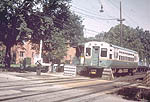
|
cta1-50s04.jpg
(166k)
A southbound Evanston train, made up of a lone 1-50
in its original paint scheme, leaves Isabella in August
1965. (Photo by Bob Epstein, Collection of
Joe Testagrose)
|
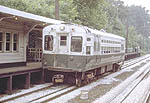
|
cta46.jpg
(141k)
A southbound Evanston Shuttle, run by lone car 46, stops at
Isabella on July 4, 1971.
(Collection of Joe
Testagrose)
|
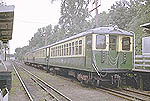
|
cta4279.jpg
(137k)
Pulling away from Isabella on its way north to Linden,
a four-car Evanston train of 4000s
is trailed by car 4279 on September 17, 1969.
(Photo by Doug Grotjahn, Collection of Joe
Testagrose)
|
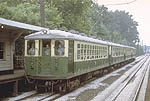
|
cta4415.jpg
(147k)
A four-car fantrip train of 4000s
is led by car 4415 as it passes Isabella on the Fourth of
July, 1971. All three of the men in the front windows of
4415 are CTA®
employees. (Photo by Joe
Testagrose)
|
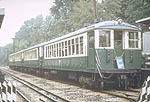
|
cta4453c.jpg
(138k)
A four-car fantrip of 4000s
passes Isabella station, heading north on August 6, 1972.
Note the sign indicating that the train will stop at
35th Street for White Sox
baseball, probably on the chains simply for
fun. (Photo by Bruno
Berzins, Collection of Joe Testagrose)
|
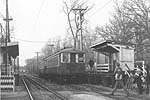
|
cta4250s.jpg
(55k)
A shot of 4000-series
Plushies northbound at Isabella in December, 1972.
(Photo by Leon Kay)
|
|

|

|












